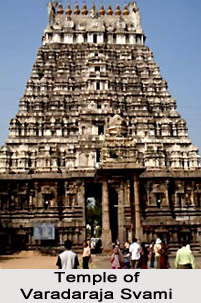 The legendary temple, with the Pallava style of architecture is provided with an exceptional dignity by the epigraphs imprinted on the walls. There are four ancient inscriptions found in this temple, the earliest of which dating back to the 13th century A.D. Three of these ancient inscriptions are written in the Tamil language and in the ancient Tamil script while one is in Sanskrit written in the Grantha script. Only one of these three epigraphs contains the date of the inscription, while the others are undated. As the historians have opined the inscription throws light on the donations made to this ancient shrine. The first of these is etched on the south base of this temple. As the researches point out this inscription is dated 1274 A.D. and belongs to the reign of a chieftain named Vijaya Gandagopala of the Telugu Chola dynasty. The inscription records the gift of a cow for maintaining a lamp by a native of Semmambakkam. The next inscription which is unfortunately incomplete belongs to the time of king Jatavarman. The king is also known as Vikrama Pandya Deva belonging to the dynasty of the imperial Pandyas of Madurai and registers the gift of land to this temple. Another epigraph in the same place records the donation of a village known as Chera Pandya-chaturvedimangalam to the administrative assembly (Sabha) of this village. The last inscription is the only one which is inscribed in Sanskrit, mentions that a Chera king granted the village of Chera Pandya-chaturvedimangalam for the enjoyment of Brahmin priests. The name chaturvedimangalam indicates that it was a place inhabited by Brahmin scholars well-versed in the Vedas and other ancient scriptures and literary texts.
The legendary temple, with the Pallava style of architecture is provided with an exceptional dignity by the epigraphs imprinted on the walls. There are four ancient inscriptions found in this temple, the earliest of which dating back to the 13th century A.D. Three of these ancient inscriptions are written in the Tamil language and in the ancient Tamil script while one is in Sanskrit written in the Grantha script. Only one of these three epigraphs contains the date of the inscription, while the others are undated. As the historians have opined the inscription throws light on the donations made to this ancient shrine. The first of these is etched on the south base of this temple. As the researches point out this inscription is dated 1274 A.D. and belongs to the reign of a chieftain named Vijaya Gandagopala of the Telugu Chola dynasty. The inscription records the gift of a cow for maintaining a lamp by a native of Semmambakkam. The next inscription which is unfortunately incomplete belongs to the time of king Jatavarman. The king is also known as Vikrama Pandya Deva belonging to the dynasty of the imperial Pandyas of Madurai and registers the gift of land to this temple. Another epigraph in the same place records the donation of a village known as Chera Pandya-chaturvedimangalam to the administrative assembly (Sabha) of this village. The last inscription is the only one which is inscribed in Sanskrit, mentions that a Chera king granted the village of Chera Pandya-chaturvedimangalam for the enjoyment of Brahmin priests. The name chaturvedimangalam indicates that it was a place inhabited by Brahmin scholars well-versed in the Vedas and other ancient scriptures and literary texts.





















